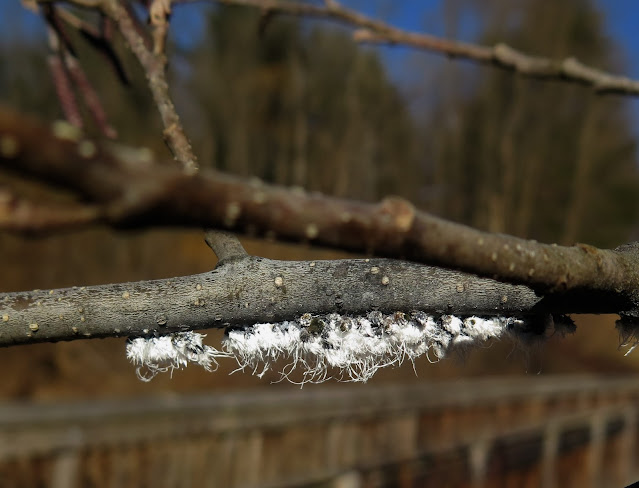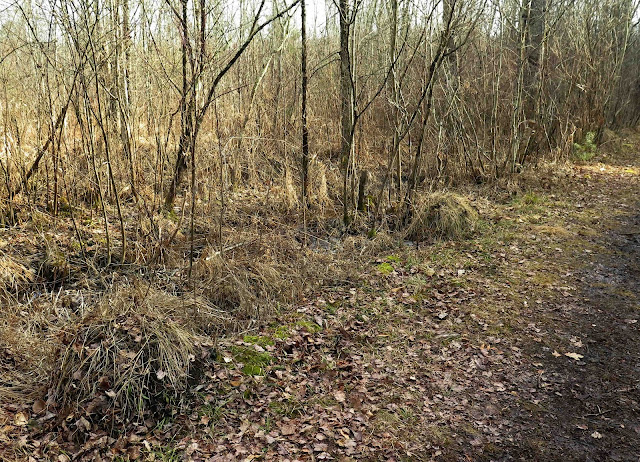We've had a whole string of blue-sky spring-warm days, and even though I'm grumpy and fearful about our lack of wintry weather, I have enjoyed being outdoors in relative comfort. Here's just a digest of some of the sites I've visited this past week and a few of the fascinating things I have found there.
Return to the Old Cemetery
In my last post, I described a recent visit not only to the Orra Phelps Nature Preserve in Wilton, but also to an old cemetery adjacent to this preserve. My photos of the various mosses that adorned the cemetery's old stone walls aroused the interest of my moss-loving friends Sue Pierce and Tom Callaghan, so together we returned to this site for further bryological explorations.
Many lichens also adorn these moss-covered stones, and this crustose gray lichen (Cinder Lichen?) appeared to be turning red. But thanks to my iNaturalist-savvy friends, I soon learned that this red stuff is actually a fungus: a lichen-inhabiting fungus called Marchandiomyces corallinus. I also learned that the fungus is probably consuming the lichen. It always amazes me to learn about so much drama occurring beneath our notice! My notice, anyway. I'm very grateful to my more internet-adept friends who can provide me with the names and behaviors of organisms I would never discover without their help.

I can always count on my eagle-eyed pal Sue to detect many treasures my own poor eyesight would never espy. I don't know how on earth she noticed these itty-bitty mushrooms that had sprouted among the ground-level roots of a small American Beech tree. But notice them she did, and our friend Tom also found out from iNaturalist that they went by the name of Fenugreek Stalkball (Phleogena fagina). This is one of our mushrooms that grows in winter, and its curry-powder-like scent of fenugreek is said to grow stronger as the mushroom ages. The brown color of the caps indicated that this normally whitish mushroom was indeed aging, but it would have been difficult for me to get my nose down close enough to see if I could smell that distinctive scent.
Saratoga's Spring Run Trail
Many friends from points further south have been finding Skunk Cabbage plants (Symplocarpus foetidus) already in bloom this over-warm winter, with open spathes and the interior spadices already covered with pollen-producing florets. So of course I had to go investigate our local wetland sites where Skunk Cabbage grows to see if I could find some for myself. One of those sites is the Spring Run Trail right in Saratoga Springs. At the far eastern end of this mile-long trail, a convenient boardwalk crosses an open marsh, leading me directly toward a low swale where Skunk Cabbage thrives.

While crossing the boardwalk, I was startled to see this cluster of Woolly Alder Aphids attached to an alder twig. These are not spring-feeding insects but are usually found in autumn, and these wingless individuals usually die off before winter begins, after producing a final generation of winged aphids that fly away to mate. A close examination revealed that these aphids were indeed no longer alive, most likely killed with the first hard frosts (despite their woolly-looking coats). How unusual to find a still-intact cluster of them in the middle of winter. Even in this over-mild winter.
Well, I DID find some colored-up spathes of Skunk Cabbage that had burst through their pale winter bracts. Their spathes still closed tight, these were growing right in the middle of a tiny flowing stream. Most of the other plants at this site were still tightly closed within their winter bracts.
Aha! Here was ONE that was fully open enough to invite any pollinators within. Problem is, few of Skunk Cabbage's pollinators are around as yet, and the interior spadix had yet to produce any pollen-bearing florets.
I'm hoping these early-opening plants aren't pushing the season so fast that any true-winter sub-freezing weather that's likely still to come won't kill them as dead as those aphids were.
Graphite Range, Redux
When I last posted a blog about this marvelous new preserve in nearby Wilton, the woods was a fairyland of fluffy snow. When I returned this week with my friends in the Thursday Naturalists, the trees were now bare of snow and the trails were now hard-packed and icy. And now the snow had receded from the steeper banks, allowing us to see what was growing there. My friend Sue alerted us that a most interesting moss was growing at this location.
I couldn't see much of the "mossy" leaves of this moss, but the greenish, white-tipped, urn-shaped spore-capsules were much in evidence. Very odd-looking spore capsules!
According to a site called In Defense of Plants, "These peculiar mosses have earned themselves the common name Powder Gun Moss (Diphyscium foliosum). The reason for this lies in those strange sessile capsules. Unlike other mosses that send their capsules up on long, hair-like seta in order to disperse their spores on the faintest of breezes, the Diphyscium capsules remain close to the ground. In lieu of wind, a Powder Gun Moss uses rain. In much the same way puffball mushrooms harness the pounding of raindrops, so too do the capsules of the Powder Gun Moss. Each raindrop that hits a capsule releases a cloud of spores that are ejected into an already humid environment full of germination potential."
How cool is that!
It was also quite cool to see such fresh-looking shiny-green leaves of the Round-lobed Hepatica (Hepatica americana) from dozens of plants that dotted the steep hillside along the trail. But lest you leap to the conclusion that these are new-sprung spring plants, these are actually the same leaves that sprouted last spring, just as the flowers were fading. They have persisted virtually all summer, fall, and winter and won't disappear until the new leaves sprout, following this year's blooms.
Bog Meadow Brook Nature Trail
Saturday was the most spring-like day of all this past week, with temps approaching 60 degrees under a mostly clear blue sky (before a late-afternoon downpour). I just had to take a walk under that sky! Choosing the nearby Bog Meadow Brook Nature Trail, I entered it via the eastern Meadowbrook Road trailhead, which led me directly toward a large sun-warmed shrub swamp. What a colorful scene it was, the sedge-tussocks rendered golden in the afternoon light, and abundant numbers of Red Osier shrubs made vivid with scarlet twigs.

Poking up from amid the tussocks were numerous stalks of seed-cluster-topped Swamp Dock (Rumex verticillatus), a plant I've been trying unsuccessfully to collect for several years. (A single plant can be seen in the center of this photo.) Our New York Flora Association Plant Atlas indicates that this plant is absent from Saratoga County, but that just means that no specimen has been contributed to state botanists for vouchering. That could be because it is not all that easy to collect. During the warm months when the plant is in flower, I cannot really wade out and pick one amid the tussocks, where I would sunk to my knees in muck. Also, during times of open water, the water here is mostly too shallow to allow for paddling. And even when the standing water here is mostly solidly frozen, the ice around the base of the tussocks is usually too weak to bear my weight. (Plus, winter-collected specimens promptly shed their seeds in the pressing process.) I just keep hoping that someday a blooming Swamp Dock plant will grow within grabbing distance from the shore.
As for this day, I had another quest. Would I be able to find the pods of a tiny orchid called Loesel's Twayblade (
Liparis loeselii) amid the jumbled dry vegetation along this trailside creek? I know where this orchid grows, but its pods are small and the same dead-grass color as everything else that grows here. But believe it or not, this little native orchid's presence is easier to locate now than it will be in June, when its tiny yellow-green flowers will be virtually undetectable amid all the other, now much taller, greenery.
And find it I did! Lucky for me, these two Loesel's Twayblade seedpods were visible against a deep-shaded background. Against a tangle of similarly colored grasses, two other plants only revealed their presence after I stooped to photograph these.





































